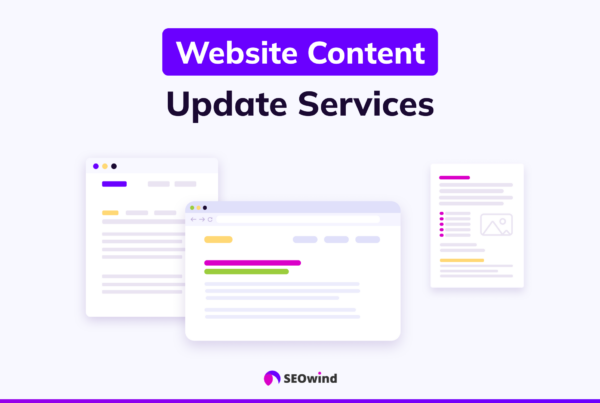Like businesses changing the customer experience to better cater to shoppers, Google continues to evolve to better serve users. The engineering team behind the search engine is expanding its capabilities in order to provide better query responses. This includes natural language processing, better recognition of connections between on-page content, and even improved synonym and preposition comprehension.
While Google continues to get smarter, it becomes better suited to providing high-quality results. But this also provides savvy businesses with an opening to optimize their content for the search engine.
One such opportunity comes in the form of keyword clustering.
TL;DR
- Keyword clustering is the process of grouping related queries with similar purchasing intent to support effective SEO activity.
- Keyword grouping brings together topically related search phrases and helps to clarify the ways in which customers try to find information about businesses and products.
- Proper keyword grouping leads to better website organization, high-quality scores, and click-through rates.
- Topic clusters and keyword clusters are related but remain distinct parts of your overall SEO approach.
- Manual and automated keyword clustering are the two primary ways you can go about SEO keyword clustering.
- The benefits of keyword clustering include understanding user intent, maximizing keyword ranking, weeding out unhelpful keywords, clarifying website structure and topic clustering, and boosting visibility and authority.
- The process of creating keyword clusters involves creating a list of keywords, identifying related keywords, grouping keywords, and creating content based on those clusters.
- Use tools to refine keyword groupings and identify new keyword opportunities.
What is keyword clustering?
A keyword cluster is a group of keywords that represent searches that share a similar purchasing intent. Clustering keywords is the process by which a business or marketer identifies and groups those related queries to support more effective SEO activity.
For example, consider different shoppers looking to buy running shoes. They might search, “new running shoes,” “Nike running shoes,” or “running shoes sale.” While each of these represents a unique query, they share an obvious connection in terms of the intent behind them. Imagine if you only focused on “running shoes” and failed to take into account keyword modifiers. Doing so would limit your ability to reach customers who might use slightly different phrasing for their searches.
How does keyword clustering work?
So, how exactly does all of this work?
The process of creating keyword groups brings together topically related search phrases. These collections include close variants – for example, “search engine optimization” and “SEO” – as well as those that contain different wording but share an intent. This helps to clarify the ways in which customers try to find information about businesses and products.
Proper keyword grouping offers you the information needed to produce content that your target audience will actually find. In addition, an effective keyword group leads to better website organization, high-quality scores, and click-through rates.
Topic clusters vs keywords clusters
Now for those of you who know about topic clustering, I’m sure this sounds fairly similar. Of course, the concepts of topic clusters and keyword clusters are related. When done correctly, they should be directly connected to each other. However, they remain distinct parts of your overall SEO approach.
Clustering keywords organizes relevant search phrases into a cluster format, which forms the basis for the structure of your digital content. When you cluster keywords, you create the foundation for a search-engine-optimized website. In essence, SEO clustering functions on two levels: keyword groups create a roadmap on which topic clusters are built to form the actual structure.
Manual versus automated keywords clustering
There are two primary ways that you can go about SEO keyword clustering: manually or using an automated grouping tool.

As much as the modern trend is to utilize automation, manually creating keyword groups has its advantages. You get direct control over the process and can interpret subtle differences in context. This can be maybe done if you have a small number of keywords to cluster.
However, the manual approach requires you to review each keyword yourself. This involves breaking them down into terms, defining their intent, and developing lists based on your targeted parameters. Obviously, automation can save you a great deal of time and effort that could otherwise be directed elsewhere.
Fortunately, you have many tools at your disposal that offer insights into the deeper meaning of your keywords. They will also help to segment them into usable groups without the need for excessive review. In particular, look for tools that provide keyword clustering machine learning as a feature.
How can keyword clustering improve SEO?
Just like any new process or requirement added to existing ways of working, SEO keyword clustering comes with costs. For example, it demands more time and resources for research and content creation than previously.
But don’t worry! The benefits of this extra work will far outweigh the costs if you do it right.

Let’s go through some of the ways that keyword clustering will enhance your SEO practices.
Understanding user intent
By fitting related keywords together, you can begin to discern the intentions and interests of your audience more easily. Words clustering should paint a picture of exactly what customers are looking for and the search intent they have.
Maximize keyword ranking
Without understanding the connections between different search phrases, your content will likely have limited search engine ranking potential. But if you group keywords, the resulting content will likely compete on multiple fronts, drastically improving its visibility and efficiency.
Weed out unhelpful keywords
Not every keyword will fit your objectives. But it’s difficult to recognize these when you’re approaching keywords on an individual basis or without proper grouping. By organizing them with a clustering strategy, it becomes easier to spot the outliers that do not match the topic or core intent.
Clarify website structure and topic clustering
With words clustering into consolidated groups, the connections between different keywords and subtopics become clearer. This should ultimately lead to more internal linking opportunities as well as help define the ideal user journey. A clustering writing strategy will naturally develop as you begin to see your website from a search engine’s perspective.
Boost visibility and authority
This is probably the most obvious and commonly desired impact. The kind of research that goes into proper clustering offers you a clearer path to effective semantic keyword grouping. This makes your content more potent and builds topical authority, both of which directly contribute to your performance and ranking.

Creating keyword and topic clusters
Hopefully, by now you’re comfortable with what keyword clusters are, how they work, and why they’re valuable. But how do you create them and where do you go from there?
While every situation is different and every business will have its processes, we believe there are best practices that any keyword grouper can follow as a starting point.
Step 1: Create a list of keywords
The first thing to do when creating clusters is to organize the information that you plan to group. In this case, that means sorting the keywords that you plan to target into an easy-to-read list.
To begin, identify a primary keyword. This should be a word or phrase that represents the most basic or common search query for your topic. Then, look into the variations, long-tail phrases, and subtopics related to that keyword. Keep in mind that a keyword modifier might not change the meaning, but it can change the SERP.
When you’re going through the related keywords, it’s important to remain consistent. Commit to a single format for documenting the results of your research. Keep track of organic difficulty, search volume, and cost-per-click metrics, all while keeping search intent in mind.
Step 2: Separate the keywords into groups
With your list of keywords complete, it’s time to start looking for patterns. Check for where users include the same words, phrases, synonyms, or subtopics in their queries. These connections will serve as the initial basis for how your keywords will end up clustered.
As you go through the list, check for a few traits in particular.
- Semantic relevance determines connections between keywords via search intent.
- Search volume and cost per click confirm that the target phrases will provide value.
- Finally, check organic difficulty to see which keywords make sense to go after.
The level of topical authority you’ve accrued and your overall brand awareness will determine which you can realistically pursue.
Step 3: Create and optimize pillar pages for your keywords
With your groupings determined, it’s time to start building the content and the structure that your keyword clustering has outlined. Your keywords should serve as a map for the topic clusters that you will create and publish on your website. And at the center of those content collections will be the pillar page that functions as the foundation for a particular topic.
Be sure to create a different landing page for each keyword cluster and include on-page SEO elements to achieve proper optimization. Potentially most important of all is the internal linking that will connect your pillar page to the rest of the content cluster. And of course, make sure that the page provides a high-quality experience itself with engaging visuals, animations, and formatting.
Step 4: Create content to support your keyword clusters
Once you have the pillar page created, it’s time to build the branches of this marketing tree. Related content should target keyword variants, long-tail versions, subtopics, and common questions. These content pieces should build from the pillar page, which should reference the related topics they will cover.
At the core of an effective topic cluster built from keyword clusters is internal linking. Hyperlinks will guide your audience from one page to the next, keeping them on your website for longer. In addition, effective linking builds topical authority, which contributes to better ranking as perceived by Google.
How to do keyword clustering with SEOwind
With SEOwind you can create content briefs with keyword clustering. Let’s have a quick look at how it works.
Top-performing pages often have content that ranks for dozens or even hundreds of keywords. It might be a challenge to figure out when and how to use keywords in your content without keyword grouping.
With keyword clustering however you can:
Here are some of the benefits of using keyword clustering:
- Improve SEO strategy: Keyword clustering simplifies the process of writing and optimizing content for search engines. By grouping similar keywords together, you can create more targeted and relevant content that is easier for search engines to crawl and index. This can help improve your website’s visibility and authority in search engine results pages (SERPs).
- Enhance content creation: With grouped keywords, you can create more comprehensive and organized content that resonates with your audience. By targeting specific keyword clusters, you can better address the needs and interests of your target audience, and provide them with the information they are looking for.
- Improve workflow: Keyword clustering streamlines your workflow, making it easier to manage your keywords and optimize your content for search engines. With a clear understanding of which keywords to target, you can plan your content creation and optimization more efficiently, saving time and resources in the process.
- Understand the user better: Keyword clustering helps you understand user intent and clarify the content structure, leading to better engagement and higher conversions. By grouping keywords by topic or theme, you can better understand the needs and interests of your target audience and create content that is more relevant and useful to them.
Let’s imagine you want to write a content brief for “green tea benefits”.
To do keyword clustering in SEOwind you just need to follow these 3 simple steps:
- Create a content brief for “green tea benefits”
- Once the data analysis is conducted, go through Competitive Analysis and choose the secondary keywords for your content.
- The keywords you’re selecting will be automatically grouped with our AI to make them as useful as possible for you.
And there you have it, your keywords are now grouped.

Common mistakes with keyword clustering to keep in mind
Now that you’ve got a clear process for clustering synonyms and related phrases, you’re nearly ready to get started. However, before doing anything new, it’s always important to understand and respect the common pitfalls that you’ll face. You have the opportunity to learn from other businesses that have tried keyword clustering and struggled.

Before we send you on your way, let’s go over some of the most common mistakes businesses make.
Insufficient research
If you’re going to properly create keyword groups filled with clustered synonyms, you’ll need fresh information and data. Choosing the right words and phrases to focus on requires consistently researching keywords search volume and click-through rates. Without committing yourself to a sufficient level of research, you could end up building a content cluster around keywords that your audience simply does not use.
This is a surefire way to ultimately lose out on the time and money that you’ll spend on content clustering and creation.
Allowing keyword cannibalization
When you’re making different pages, you need to differentiate them sufficiently. Otherwise, you might find content competing against each other for volume. Distinct pieces of content that are not differentiated enough from each other will end up competing for clicks and accidentally place a firm ceiling on what either can accomplish.
This is a great example of why research is so important. With sufficient insight into your keywords, proper segmentation and grouping, and optimized content, you can ensure sufficiently unique content to avoid such a scenario.
Failing to maintain clusters
Just because you’ve identified a relevant set of keywords as the basis of your keyword clustering SEO strategy doesn’t mean that they will remain that way forever. Your audience’s interests and industry trends are liable to change over time, after all. This is another way that research comes into play.
As things change and customers move onto new topics, make sure to keep your SEO keyword clusters in line with those updates.
Inadequately updating content
It’s not just keywords that change. The content you create will not exist in a void. As the world and industries change, so will the effectiveness of old articles or blogs. Rather than leaving them to gather dust, make sure to go back occasionally and look for ways to modernize existing content. Doing so will keep your rankings high and avoid reducing your perceived topic authority.
Weak internal linking
Every link on a page represents a fresh opportunity to keep your readers on your website rather than having them return to Google. That means that every single page should have hyperlinks that direct people to more content.
So, don’t only link between your cluster pages and the pillar page. Make sure to have cluster pages link to each other and even to other clusters entirely if a relationship exists. Failing to do so just gives potential customers a reason to go elsewhere when looking for answers.
Poor-quality pillar pages
When setting up the content based on your keyword clusters, the entire structure will hinge on the central topic page, otherwise known as a pillar page. This is the starting point where members of your audience will first engage with your website. The pillar page will also act as the hub from which they will explore your other content.
Oftentimes, businesses make this page either too specific or too vague. The first mistake risks answering your readers’ questions so thoroughly that they don’t feel compelled to explore further. Meanwhile, the second mistake results in a lack of interest in the topic. Instead, you want to strike a balance so that people want to know more and know exactly where to find that information.
Key Takeaways
When done well, keyword clustering can take your SEO practices to the next level. Research carefully, define your objectives, and see how much better you understand your audience and provide them with an excellent experience!


